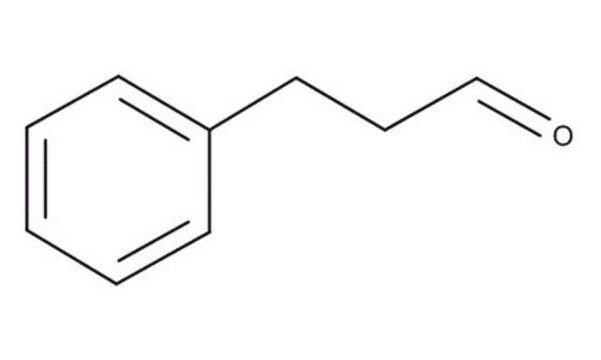W288608
2-Phenylpropionaldehyde
≥95%, FCC, FG
동의어(들):
2-Phenylpropanal, Hydratropaldehyde
로그인조직 및 계약 가격 보기
모든 사진(1)
About This Item
Linear Formula:
CH3CH(C6H5)CHO
CAS Number:
Molecular Weight:
134.18
FEMA Number:
2886
Beilstein:
1905601
EC Number:
유럽평의회 번호:
126
MDL number:
UNSPSC 코드:
12164502
PubChem Substance ID:
플래비스(Flavis) 번호:
5.038
NACRES:
NA.21
추천 제품
생물학적 소스
synthetic
Quality Level
Grade
FG
Halal
Kosher
Agency
meets purity specifications of JECFA
규정 준수
EU Regulation 1334/2008 & 178/2002
FCC
FDA 21 CFR 172.515
분석
≥95%
refractive index
n20/D 1.517 (lit.)
bp
92-94 °C/12 mmHg (lit.)
density
1.002 g/mL at 25 °C (lit.)
응용 분야
flavors and fragrances
문건
see Safety & Documentation for available documents
식품 알레르기항원
no known allergens
감각 수용성의
fresh; green; floral
저장 온도
2-8°C
SMILES string
[H]C(=O)C(C)c1ccccc1
InChI
1S/C9H10O/c1-8(7-10)9-5-3-2-4-6-9/h2-8H,1H3
InChI key
IQVAERDLDAZARL-UHFFFAOYSA-N
유사한 제품을 찾으십니까? 방문 제품 비교 안내
일반 설명
2-Phenylpropionaldehyde is used in perfumes for its green hyacinth odor.
애플리케이션
- Cytotoxicity, early safety screening, and antimicrobial potential of minor oxime constituents of essential oils and aromatic extracts.: Explores the safety and effectiveness of 2-Phenylpropionaldehyde among other compounds in essential oils, highlighting its potential antimicrobial properties and implications for food safety and preservation (Strub DJ et al., 2022).
- Spectroscopic Evidence for a Cobalt-Bound Peroxyhemiacetal Intermediate.: This study provides spectroscopic evidence of a cobalt-bound intermediate in reactions involving 2-Phenylpropionaldehyde, advancing our knowledge of chemical reaction mechanisms and catalysis (Cho J et al., 2021).
Storage Class Code
10 - Combustible liquids
WGK
WGK 1
Flash Point (°F)
174.2 °F
Flash Point (°C)
79 °C
개인 보호 장비
Eyeshields, Gloves, type ABEK (EN14387) respirator filter
시험 성적서(COA)
제품의 로트/배치 번호를 입력하여 시험 성적서(COA)을 검색하십시오. 로트 및 배치 번호는 제품 라벨에 있는 ‘로트’ 또는 ‘배치’라는 용어 뒤에서 찾을 수 있습니다.
tert-Butyldimethylsilylated cyclodextrins: versatile chiral stationary phases in capillary gas chromatography.
Maas B, et al.
Journal of Chromatographic Science, 33(5), 223-228 (1995)
M Popović et al.
Chemical research in toxicology, 17(12), 1568-1576 (2004-12-21)
Felbamate (2-phenyl-1,3-propanediol dicarbamate, FBM) can cause aplastic anemia and hepatotoxicity. The mechanism of FBM-induced toxicities is unknown; however, it has been proposed that 2-phenylpropenal, a reactive metabolite of FBM, is responsible. The pathway leading to this metabolite involves hydrolysis of
C D Thompson et al.
Chemical research in toxicology, 9(8), 1225-1229 (1996-12-01)
We propose that 3-carbamoyl-2-phenylpropionaldehyde is an intermediate in the metabolism of felbamate, an anti-epileptic drug with a unique profile of the therapeutic activity, and undergoes a cascade of chemical reactions responsible for the toxic properties of the parent drug. To
Shane G Roller et al.
Chemical research in toxicology, 15(6), 815-824 (2002-06-18)
Felbamate is an anti-epileptic drug associated with hepatotoxicity and aplastic anemia. These toxicities are believed to be mediated by the formation of the reactive species 2-phenylpropenal. 4-Hydroxy-5-phenyl-[1,3]oxazinan-2-one is a metabolic precursor for 2-phenylpropenal. 4-Hydroxy-5-phenyl-[1,3]oxazinan-2-one exists in equilibrium with 3-oxo-2-phenylpropyl carbamate
Robert J Parker et al.
Chemical research in toxicology, 18(12), 1842-1848 (2005-12-20)
Evidence has been presented suggesting that a reactive metabolite, 2-phenylpropenal (ATPAL), may be responsible for the toxicities observed during therapy with the antiepileptic drug felbamate (FBM). Formation of ATPAL from its unstable immediate precursor, 3-carbamoyl-2-phenylpropionaldedhyde (CBMA) requires the loss of
자사의 과학자팀은 생명 과학, 재료 과학, 화학 합성, 크로마토그래피, 분석 및 기타 많은 영역을 포함한 모든 과학 분야에 경험이 있습니다..
고객지원팀으로 연락바랍니다.







